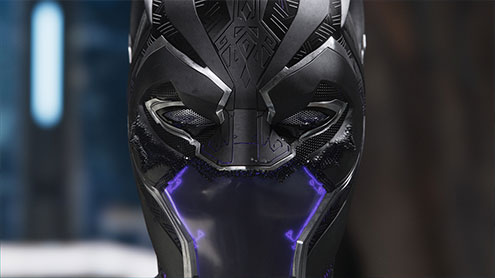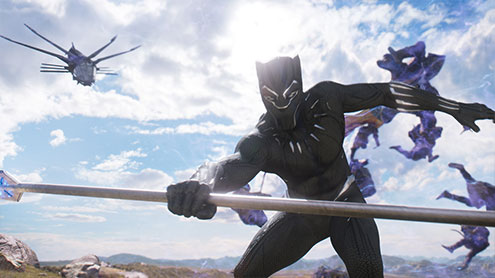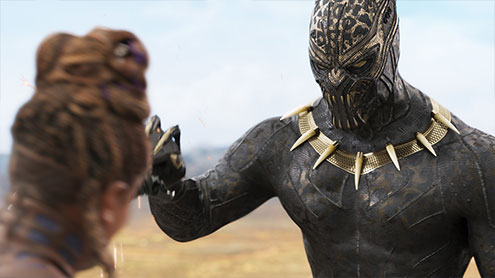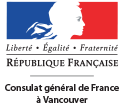INTERVIEW 2018
by Ian Failes, Spark CG Society
February 23, 2018
Tailor-made: Weaving the Suits of Black Panther
A trademark of recent superhero films is, of course, the main character’s super suit. Oftentimes, owing to complex stunts and some costume re-designs, the final suits are often digitally enhanced or augmented, or occasionally fully computer-generated.
In the case of Ryan Coogler’s Black Panther, the title character’s distinctive Wakandian and vibranium-ladden wardrobe was predominantly CG. Actor Chadwick Boseman and various stunt performers wore versions of the suit during principal photography, but the many visual effects vendors on the film shared a digital Black Panther suit asset to complete final shots.
Leading the effort on the Black Panther suit asset, and that of his adversary, Killmonger (Michael B. Jordan), was Method Studios. Method Studios visual effects supervisors Todd Sheridan Perry and Andy Brown run down the challenges of realizing the sleek costumes, and other costumes the studio built while creating several digital doubles for the film.
To get the Black Panther suit into the CG realm, costume designer Ruth E. Carter’s Black Panther and Killmonger creations were scanned by Clear Angle, which also carried out scans of just about every actor in costume on the film. Photogrammetry sessions and texture shoots were also undertaken. The Black Panther suit, in particular, was patterned with many tiny triangles and Wakandan font throughout it that needed to be replicated in the digital version.
Still, Method Studios says it was extremely helpful having the actors and stunt performers wearing practical suits on set. “Having the actors in the suits was fantastic because we had lighting reference for what it should look like and that helped to get the suit into the scene so that the lighting felt the same as the rest of the practical photography,” says Perry.

Close-up on the suit as it’s being shown to T’Challa / Black Panther (Chadwick Boseman). Image © Marvel Studios 2018.
“We also had production send the actual costume to us so that we could get additional detail if we needed to. That helped with W’Kabi’s (Daniel Kaluuya) outfit and with the Dora armour for the all-female Wakanda special forces. Just the modellers and texture artists getting to hold those pieces really helps with getting to know what the volume is and how it’s shaped, that you don’t necessarily get in photography.”
During production on the film, a suit re-design occurred and that required a number of changes to be made while the CG build was in process. Method Studios went to and fro with Marvel’s visual development team. “We ended up doing a great first build,” notes Brown, “and then there was quite a lot of design changes along the way - little tweaks, just mainly tweaks of details. It included, say, how does the claws operate, and there was a bit of work on updating the helmet, too.”

Method Studios’ CG suit sees much action in the final battle in Wakanda. Image © Marvel Studios 2018.
One of the reasons for the re-design was that, from some angles, Black Panther was thought to look too kitten-like, with large eyes and rounded features. So Method Studios instead made the CG suit “a little more angular and a little bit more aggressive,” says Perry. “We shrunk down his eyes and made the eyebrows and other areas have more angular features.”
Method Studios’ approach in replacing live action suit performances revolved around roto-animation. The idea was to always, where possible, replicate the original performance. Only where a slightly more exaggerated action was required or where the stunt involved significant leaping or superhero style fighting would a completely key-framed animation come into play. Motion capture was also a resource that aided the final performance.

Killmonger’s suit was also a Method Studios creation. Image © Marvel Studios 2018.
“The stunt guys are really exceptional so a lot of their stuff we just used,” says Perry. “There’s this one move where Killmonger has his little short spear type thing and he’s hitting him and Black Panther is parrying and Killmonger takes the spear and flips it behind him around his head and he captures it with this hand and then comes down, and that was done on set. I was watching it and I was going, how, did that just happen? Did he just like, actually do that move? And so all of that type of stuff, they would have utilised because it’s good stuff.”
All images © Marvel Studios 2018. All Rights Reserved.
 |
Ian Failes is a Sydney-based writer specializing in visual effects and animation. He also collects memorabilia from the film Speed. Follow him at @vfxblog. |
![]()
![]()
© 2024 · Spark CG Society














